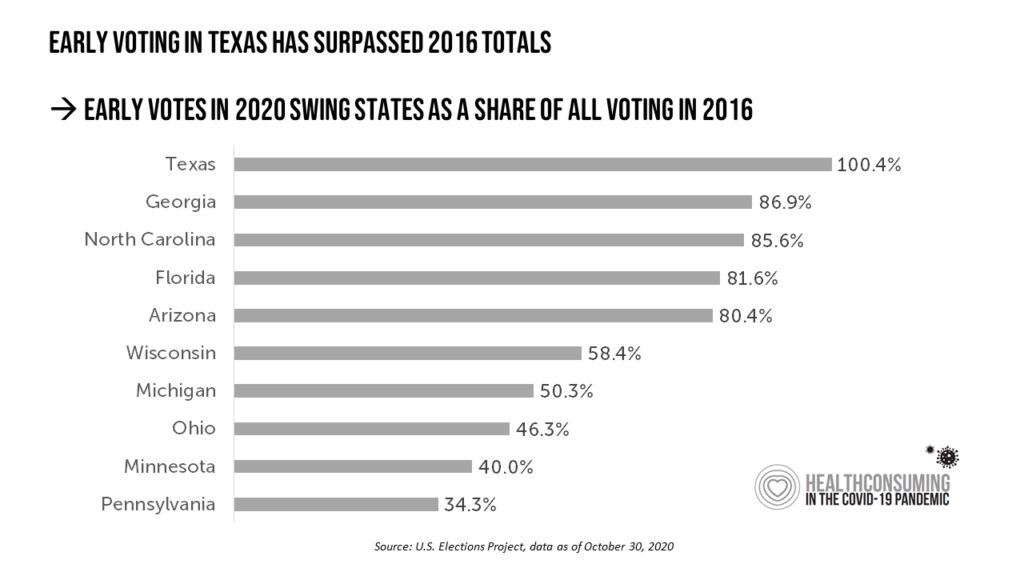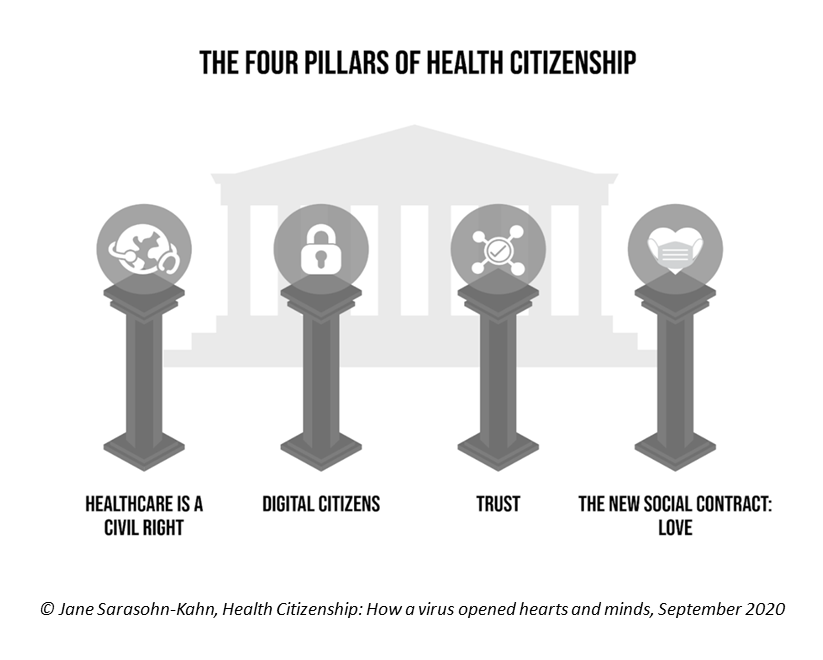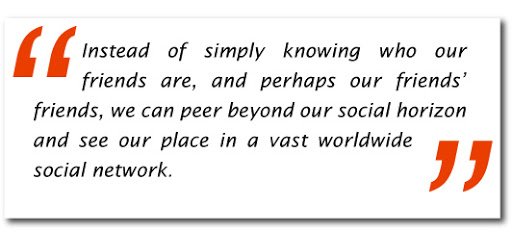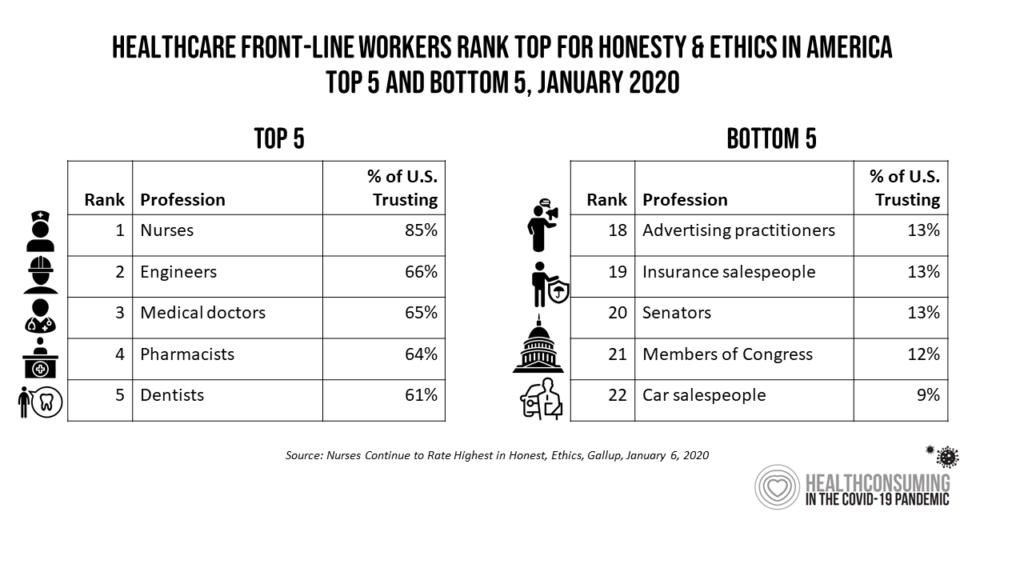In the 2018 mid-term elections, U.S. voters were driven to polls with health care on their minds. The key issues for health care voters were costs (for care and prescription drugs) and access (read: protecting pre-existing conditions and expanding Medicaid).
Issue #2 for 2018 voters was the economy.
In 2020, as voting commences in-person tomorrow on 3rd November, U.S. voters have lives and livelihoods on their minds. It’s the pandemic – our physical lives looming largest in the polls – coupled with our fiscal and financial lives.
Health is translating across all definitions for U.S. voters in November 2020: for health care and physical health, financial health, mental health, and societal health.
And the energy to cast votes is a signal sparking Americans recognizing the importance of health citizenship.
 Take Texas: Texans’ voting engagement leading up to Election Day has shattered records. Historically, just over one-half of eligible voters in Texas have voted. In the pre-election ballots cast, the number of ballots cast has surpassed total 2016 voter turnout.
Take Texas: Texans’ voting engagement leading up to Election Day has shattered records. Historically, just over one-half of eligible voters in Texas have voted. In the pre-election ballots cast, the number of ballots cast has surpassed total 2016 voter turnout.
Furthermore, the Texas voting picture says a lot about the turbocharged state of the American electorate, where early voting has over-indexed on economic diversity and women.
Early voting via absentee and mail-in ballots has increased dramatically in many U.S. states expanding access to these methods for the 2020 election, where these options have been made available due to the pandemic and electoral leadership throughout the U.S. concerned about state citizens’ public health in the era of COVID-19.
Fast Company made the argument that “voting is easier than ever,” that the “voting ecosystem is flourishing.” There are at least three reasons fostering this healthier voting ecosystem: better ballot design, more information available to voters on county and state websites, and, finally, more places to vote in more drop boxes and the ability to vote by mail from home.
The pandemic has accelerated the omni-channel phenomenon in retail for consumers to shop in person in stores, and online via many platforms from phone to computer. As COVID-19 has re-shaped us as consumers in retail, we are re-shaping as health consumers, too, as well as health citizens via “omni-channel voting” whether via absentee, mail-in, or in-person.
In this pandemic time, we vote not just for healthcare, with concerns about the potential for an ACA repeal from the bench of the newly-re-formed U.S. Supreme Court, to concerns under the larger umbrella of “health.”
![]() To be sure, there is bi-partisan support for “protecting pre-existing conditions,” a key component of the Affordable Care Act. Democratic and Republican platforms differ on how pre-existing conditions would be protected, however.
To be sure, there is bi-partisan support for “protecting pre-existing conditions,” a key component of the Affordable Care Act. Democratic and Republican platforms differ on how pre-existing conditions would be protected, however.
But health is driving people to vote across all the dimensions of the issue:
 We can and must hold two thoughts in our brain at the same time and act on them: our lives and our livelihoods are interwoven in the pandemic. Without crushing the pandemic in our communities across the nation, neither our local and household economies nor our health and well-being can flourish.
We can and must hold two thoughts in our brain at the same time and act on them: our lives and our livelihoods are interwoven in the pandemic. Without crushing the pandemic in our communities across the nation, neither our local and household economies nor our health and well-being can flourish.
Enter health citizenship.
Health citizenship rests and thrives on four pillars:
- Access to health care
- Privacy and security of our personal information
- Trust, in science and in each other
- A new social contract for health, which is love.
The record numbers of U.S. voters exercising their right to do so embodies the fourth pillar in the social contract.
We are connected as health citizens in this process. We learned from Christakis and Fowler in their seminal research on social networks that we are profoundly Connected, as your behaviors impact my health, and mine impact yours.
 In the present moment, as coronavirus cases exceed 9 million people in the U.S., prevention strategies take the form of individuals wearing masks, physically distancing, and following peer-reviewed scientific evidence.
In the present moment, as coronavirus cases exceed 9 million people in the U.S., prevention strategies take the form of individuals wearing masks, physically distancing, and following peer-reviewed scientific evidence.
In this election, we are grappling our way toward health citizenship, motivated by the pandemic, family finances, mental and emotional health, and equity and civil rights.
I first heard the phrase “health citizenship” when working in Europe in the late 1990s. I met a man named Jean Claude Healy, who led an information technology division in the European Commission with a strong focus on a new concept called “eHealth.” He was the first person to speak to me about “health citizenship.”
My friend and colleague Denise Silber, with whom I’ve been on the digital health journey from the beginning, lives in France and works globally. In 2003, Denise wrote that, “eHealth is the means to deliver responsive healthcare tailored to the needs of the citizen,” invoking that “C”-word quite purposefully.
 We fast-forward to the era of cloud computing and AI to find that Microsoft has adopted the health citizen persona in their work with health systems around the world, such as in this explanation on democratizing AI to improve citizen health, published in 2017. Professor James Thomas of the University College London noted the Cochrane Crowd-sourced AI research enabled, “a virtuous circle whereby the AI makes the crowd more efficient, and then the crowd, by supplying more data, makes the AI more accurate.”
We fast-forward to the era of cloud computing and AI to find that Microsoft has adopted the health citizen persona in their work with health systems around the world, such as in this explanation on democratizing AI to improve citizen health, published in 2017. Professor James Thomas of the University College London noted the Cochrane Crowd-sourced AI research enabled, “a virtuous circle whereby the AI makes the crowd more efficient, and then the crowd, by supplying more data, makes the AI more accurate.”
In this case, 5,000 patients came together from 117 countries to populate that “virtuous circle,” sharing personal health information for the benefit of each other, and future patients.
In the U.S., voting in 2020 has everything to do with our health baked into every aspect of our lives. In the new social contract for health in America, love means wearing the mask, love means voting, and love means trusting in science, our doctors and nurses — the most beloved professions for honesty and ethics in America.
